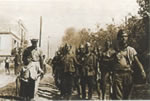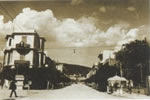MODERN HISTORY OF THE CITY
 |
View of Serres during the Turkish occupation. |
The first decades of the Twentieth Century promised unrest in the Balkans. The fact that different nations, languages, and religions had coexistence there for many centuries rendered particularly tricky the problem of distributing land following the obvious inability of the Ottoman Turks to maintain their dominance in the region.n 1912, the three Balkan powers -Greece, Bulgaria and Serbia- put aside their intense rivalry to form a tripartite League centred in Sophia, and dispatched a memorandum to the Turkish government requesting the introduction of reform within the Ottoman Empire. The Sultan refused, as expected, and the Balkan powers duly declared war at the beginning of October 1912.
 |
While the Ottoman expeditionary force in Strymona had already withdrawn to Giannitsa, the Serres garrison abandoned the city along with the Turkish authorities on October 24. The following day the Bulgarian forces entered the city. The Greek inhabitants of Serres welcomed the withdrawal of the Turks with enthusiasm, and within a few days a regiment of Greek cavalry had been stationed in the city.The collapse of the Turkish Front throughout the Balkans and the Aegean forced the Great Powers to recognise a new territorial status quo. The definitive treaty between the combatants was signed in London in May 1913, and lent its seal of approval to the removal of Turkish dominance from the Aimos Peninsula. It did not, however, lay down any new territorial divisions in the Balkans.In the ensuing period, there were a great many hostile incidents in the areas under joint Greek and Bulgarian control. In the Serres region, a number of such incidents took place in Paggaio and Nigrita and led to the Greek regiment withdrawing from the city to evade capture. It had been clear from the start, however, that the three powers had started the war fully intent on taking advantage of any ensuing military or diplomatic situation for their own gain.
 |
Serres, burnt to the ground. |
The Bulgarians' obviously expansionist leanings led to the signing of a Greco-Serbian Non-Aggression Pact and Defensive Alliance in May 1913. June saw Bulgarian forces advancing on Greek and Serbian outposts in Gevgeli and Nigrita. The Second Balkan War had begun.The Greek army took Kilkis, Lachana and Doirani (19 - 22 June), and marched on Strymona. The Bulgarians blew up the bridges over the river and withdrew. In Serres itself they took hostages, executed a number of them, and forbade any movement within the city. Despite this, an armed Christian and Muslim militia was mustered on the suggestion of the Bishop, Apostolos Christodoulos, in an attempt to protect the city. The Seventh Division of the Greek army, then in Strymona, marched towards the city of Serres, but difficulties with military operations in Gevgeli and intelligence on Bulgarian withdrawals led to a postponement of the capture of the city. When the first Greek troops entered the city on June 28, they realised just how fateful that delay had been. Having bombarded the city, the Bulgarians had withdrawn and then set light to the whole centre with diesel. The blaze had burnt the greater part of the city to the ground: 1000 shops and 4,050 houses out of a total of 6,000. The following day, June 29, the Greek army officially captured the city.August 1913 saw the signing of the Treaty of Bucharest, in accordance with which Eastern Macedonia, as far as and including Kavala, was to be under Greek domination.
 |
All of these events led to population movements in the region. Indeed, records show large groups of people to have been on the move as early as August 1913: the Muslim inhabitants of the area were heading away, while Greeks from Stromnitsa, Meleniko and Petritsi were on the move towards areas now Greek.Shortly afterwards, the First World War brought new terrors to the city of Serres. The involvement of Turkey and Bulgaria on the side of Germany and Austro-Hungary, and the internal conflict between the neutrals (King Constantine and conservative, royalist forces) and supporters of an alliance with the Anglo-French (Venizelos and the Liberals) led to turmoil throughout the country and ultimately to the National Schism.By the end of June 1915, 21,000 refugees from Bulgaria, Thrace, Asia Minor and the Caucasus had settled in the Serres area.In August 1915, the Rouble Fortress was handed over to the Bulgarians by Royalists, and Macedonia began to gradually fall under German and Bulgarian control.On August 28, 1916, the Bulgarians entered Serres. The conditions they imposed on the inhabitants of the city were intolerable (including, among others, a curfew and the requisitioning of all foodstuffs), and arrests, physical assault and executions became part of everyday life. All of this, added to the forcible removal of inhabitants of the city, soon led to a dramatic fall in the population of Serres. This state of affairs lasted until September 1918, when Bulgaria sued for peace and Greek forces re-entered the city.
 |
Hostages on their way from Serres to Bulgaria. |
The withdrawal of the Bulgarians meant even further losses for the city and the prefecture since it was accompanied by the destruction of monuments and archives, as well as the removal of codices, hand-written parchments and vessels from churches and monasteries. The libraries of the monasteries of Timios Prodromos and Kosfinisa were stripped bare as early as 1917.Furthermore, the Bulgarians had transported thousands of Greeks, including many from the Serres area, to labour battalions as hostages during the First World War. None of them would ever return.The Asia Minor catastrophe and the Treaty of Lausanne in July 1923 brought a new wave of refugees to Serres from Asia Minor, the Black Sea, and Eastern Thrace. By 1928, 70,000 refugees had settles in the Prefecture of Serres, of whom 13,534 were absorbed by the city itself. According to the 1920 census, the population of the city was 14,486, while 8 years later, that number had risen to 26,640. Of all the cities in Macedonia, Serres was second only to neighbouring Drama in taking in the largest percentage of refugees. The presence of these new populations gave new demographic and socio-economic life to the city.
 |
 |
Venizelist army officers engineered a coup on March 1, 1935. By March 3 every unit between Strymona and Evros had mutinied. In Serres, civilians from the Venizelist movement joined the 19th Regiment and seized the Prefecture and the telegraph office, and carried out arrests of both officers and civilians. On March 9, the pro-government airforce proceeded with intimidatory bombardments of the city. The coup collapsed within a few days and its supporters were removed from public life.During the war against the Italians in 1940, young citizens of Serres took part in battles around Tower "731", which have gone down in the military history of both sides as one of the most bloody battles of the whole war.On April 9, 1941, German forces took Serres, and on April 25 the Bulgarian army entered the city, the Germans having handed the city over to the Bulgarians. The Bulgarian occupation did everything it could to Bulgarize the city via the use of the Bulgarian language, the changing of place names, and other methods. The participation of Serres people in the resistance led to the arrest and execution of citizens, and on March 5, 1943 the Greek Jewish community of Serres was transported in its entirety to concentration camps in Poland, where they were exterminated.
 |
In 1944 the Bulgarian forces withdrew from Eastern Macedonia, and on September 14, 1944, the first ELAS units entered Serres. September 29 saw the first post-war, free, democratic elections in the city. Shortly afterwards the city was overtaken by the terrible events of the civil war.After the Second World War and throughout the entire Cold War period- that is until the collapse of the status quo in the countries of the former Eastern Bloc- the prefecture's proximity to the People's Republic of Bulgaria and the military dogma of "we are threatened from the North" meant a huge military presence in the prefecture and the city, and the imposition of military-type limitations.The last decades of the Twentieth Century have seen Serres fully integrate into the European Union, while simultaneously improving relations with the countries neighbouring it to the North; countries which were very significant trading partners until the first two decades of the last century.
 |
| ELAS units entering the city. Sptember 1944. |
 |
View of the post-war city. |
 |
The city today. |
 |
The city between the wars in September 1944. |
Writer:
Dimitra Tsesmetzi-Maragaki
|











